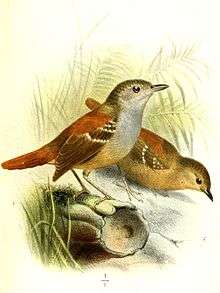Rufous-tailed antwren
| Rufous-tailed antwren | |
|---|---|
 | |
| Illustration by Joseph Smit, 1890 | |
| Scientific classification | |
| Kingdom: | Animalia |
| Phylum: | Chordata |
| Class: | Aves |
| Order: | Passeriformes |
| Family: | Thamnophilidae |
| Genus: | Epinecrophylla |
| Species: | E. erythrura |
| Binomial name | |
| Epinecrophylla erythrura (Sclater, 1890) | |
| Subspecies | |
|
See text | |
| Synonyms | |
| |
The rufous-tailed antwren (Epinecrophylla erythrura) is a species of bird in the family Thamnophilidae. It was formerly placed in the genus Myrmotherula. It is found in Brazil, Colombia, Ecuador, and Peru. Its natural habitat is subtropical or tropical moist lowland forests.
Description
The rufous-tailed antwren grows to a length of about 11.5 cm (4.5 in) and has a slightly longer tail than other members of the genus. The male has olive-brown upper parts with a chestnut back and tail, and pale tips to the wing coverts. The throat and breast are grey, sometimes with a dark "scaled" effect, and the belly is olive brown. The female is similar but the throat and breast are buff-ochre and the belly dull brown. In both sexes, the iris is red or orange and the bill is dark. The male is the only member of the genus without a contrasting throat patch. The female is similar in appearance to the stipple-throated antwren (Epinecrophylla haematonota), but that has no chestnut on its back. The song is a high-pitched, rather squeaky series of notes.[2]
Distribution
The rufous-tailed antwren is endemic to the moist tropical forests of northern South America. Its range includes western Brazil, southeastern Colombia, eastern Ecuador and eastern Peru. This bird occurs in the lower and middle storeys of the forest at altitudes of up to 700 m (2,300 ft).[2]
Subspecies
Two subspecies are recognized:
- E. e. erythrura (Sclater, PL, 1890) - southeastern Colombia to northeastern Peru and northwestern Brazil.
- E. e. septentrionalis (Zimmer, JT, 1932) - from eastern Peru and the western Amazon basin
Ecology
The rufous-tailed antwren often feeds in pairs or small groups, often joining mixed flocks of small birds flitting through the lower parts of the canopy, often foraging higher in the trees than other related species.[2] The diet consists of insects and spiders, most of which are found by probing into rolled-up leaves. The nest is a dome-shaped construction with a side-entrance; breeding takes place in February in Ecuador.[3]
Status
The rufous-tailed antwren is a fairly common species with a very wide range. The population appears to be stable and the International Union for Conservation of Nature has assessed its conservation status as being of "least concern".[1]
References
- 1 2 BirdLife International (2012). "Epinecrophylla erythrura". IUCN Red List of Threatened Species. Version 2013.2. International Union for Conservation of Nature. Retrieved 26 November 2013.
- 1 2 3 Ridgely, Robert S.; Tudor, Guy (2009). Field Guide to the Songbirds of South America: The Passerines. University of Texas Press. p. 343. ISBN 978-0-292-71748-0.
- ↑ Zimmer, K; Isler, M.L. "Rufous-tailed Antwren (Myrmotherula erythrura)". Handbook of the Birds of the World Alive. Lynx Edicions, Barcelona. Retrieved 30 July 2016.
- Isler, M., D. Lacerda, P. Isler, S. Hackett, K. Rosenberg, and R. Brumfield (2006). Epinecrophylla, a new genus of antwrens (Aves: Passeriformes: Thamnophilidae). Proceedings of the Biological Society of Washington 119(4): 522–527
